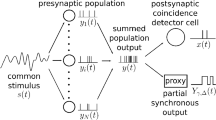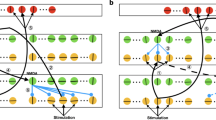Summary
Well-known theoretical concepts for visual threshold behavior are: 1. the quantum coincidence model which describes particularly threshold-dependence on presentation time and teststimulus geometry; 2. the quantum fluctuation model which includes description of thresholddependence on luminance and color of a masking background. In this paper it is demonstrated that analog models of static as well as dynamic inhibition in the retina can be extended to more realistic stochastic models. This can be done by consideration of the coincidence operations as expressed in the quantum coincidence and quantum fluctuation models for visual threshold behavior. In this model coincidence detectors indicated as C-gates are the essential components. It is demonstrated that threshold-gates as are frequently used in models in neurophysiology do not permit development of the more realistic asynchronous circuits. Further it is pointed out that electronic neuron models and stochastic and nonstochastic models of nerve-functions of other authors in fact are either special simplifications of the proposed C-gates or lead naturally to C-gates for their further development.
Similar content being viewed by others
Bibliography
Békésy, G. von: Neural inhibitory units of the eye and skin. Quantitative description of contrast phenomena, J. opt. Soc. Amer. 50, 1060 (1960).
Bishop, P. O., W. R. Levick, and W. O. Williams: Statistical analysis of the dark discharge of lateral geniculate neurons. J. Physiol. (Lond.) 170, 598 (1964).
Bouman, M. A.: Mechanisms of peripheral dark adaptation. J. opt. Soc. Amer. 42, 941–950 (1952b).
— History and present status of quantum theory in vision. In: Sensory Communications (ed. W.A. Rosenblith). London: M. I. T. Press/John Wiley Sons Inc. (1961).
— Efficiency and economy in impulse transmission in the visual system. Acta psychol. (Amst.) 23, 239–241 (1964).
Bouman, M. A., and C. G. F. Ampt: Fluctuation theory in vision and its mechanistic model. In: Performance of the eye at low luminances (ed. M. A. Bouman and J. J. Vos). Excerpta med. (Amst.) Int. Congr. Ser. No 125 (1966).
Bouman, M. A., and G. van den Brink: On the integrate capacity in time and space of the human peripheral retina. J. opt. Soc. Amer. 42, 617 (1952a).
Bouman, M. A., and J. ten Doesschate: Nervous and photochemical components in visual adaptation. Ophthalmologica (Basel) 126, 222 (1953).
—, and J. ten Doesschate The mechanism of dark adaptation. Vision Res. 1, 386 (1962).
Bouman, M. A., and H. A. van der Velden: The two-quanta hypothesis as a general explanation for the behavior of threshold values and visual acuity for the several receptor systems of the human eye. J. opt. Soc. Amer. 38, 570 (1948).
Bouman, M. A., J. J. Vos, and P. L. Walraven: Fluctuation theory of luminance and chromaticity discrimination. J. opt. Soc. Amer. 53, 121 (1963).
Brink, G. van den, and M. A. Bouman: Variation of integrative actions of the retina system: an adaptational phenomenon. J. opt. Soc. Amer. 44, 616 (1954).
—, and M. A. Bouman Quantum coincidence requirements during darkadaptation. Vision Res. 3, 479 (1963).
Cox, D. R., and W. L. Smith: On the superposition of renewal processes. Biometrika 41, 91 (1954).
Dertouzos, M. L.: Threshold logic — a synthesis approach. Cambridge, Mass.: M. I. T. Press, 1965.
Eccles, J. C.: Inhibitory controls on the flow of sensory information in the nervous system. In: Information processing in the nervous, system (eds R. W. Gerard and J. W. Duyff). Int. Congr. Ser. No 49, Excerpta Medica Foundation 1962.
Grind, W. A. van de, and M. A. Bouman: A model of a sampling-unit of the human peripheral retina. Kybernetik 4, 136 (1968).
Hartline, H. K., F. Ratliff, and W. H. Miller: Inhibitory interaction in the retina and its significance in vision. In: Nervous inhibition (ed. E. Florey). Oxford: Pergamon Press 1961.
Hoopen, M. ten: Multimodal interval distributions. Kybernetik 3, 17 (1966).
Hecht, S.: The quantum relations of vision. J. opt. Soc. Amer. 32, 42 (1942).
Jenik, F., and D. Adolphs: Koinzidenzfilter mit kurzen Impulsen. Kybernetik 2, 287 (1965).
Kirschfeld, K., u. W. Reichardt: Die Verarbeitung stationärer optischer Nachrichten im Komplexauge von Limulus. Kybernetik 2, 43 (1964).
Kosel, G.: Frequenzmessung mit einem Diskriminator. AEÜ 16, 359 (1962).
Küpfmüller, K., u. F. Jenik: u'ber die Nachrichtenverarbeitung in der Nervenzelle. Kybernetik 1, 1 (1961).
Ratliff, F.: Mach bands: Quantitative studies on neural netwerks in the retina. New York: Holden-Day Inc. 1965.
Ratliff, F., H. K. Hartline, and W. H. Miller: Spatial and temporal aspects of retinal inhibitory interaction. J. opt. Soc. Amer. 53, 110 (1963).
Ratliff, F., and G. G. Mueller: Synthesis of “On-Off” and “Off” responses in a visual neural system. Science 126, 840 (1957).
Reichardt, W.: Über das optische Auflösungsvermögen der Facettenaugen von Limulus. Kybernetik 1, 57 (1961).
— Theoretical aspects of neural inhibition in the lateral eye of Limulus In: Information processing in the nervous system (eds. R. W. Gerard and J. W. Duyff). Int. Congr. Ser. No 49, Excerpta Medica Foundation, Amsterdam 1962b.
Reichardt, W., u. G. MacGinitie: Zur Theorie der lateralen Inhibition. Kybernetik 1, 155 (1962a).
Reiss, R. F.: A theory of resonant networks. In: Neural theory and modelling (ed. R. F. Reiss). Stanford: University Press 1964.
Rose, A.: The sensitivity performance of the human eye on an absolute scale. J. opt. Soc. Amer. 38, 196 (1948).
Ross Ashby, W.: Mathematical models of computer analysis of the function of the central nervous system. Ann. Rev. Physiol. 28, 89 (1966).
Schieff, R.: Koinzidenz-Siebschaltungen. Diss. Techn. Hochschule Hannover 1962.
— Koinzidenzfilter als Modell für das menschliche Tonhöhenunterscheidungsver- mögen. Kybernetik 2, 1, 8 (1963).
Varjú, D.: Vergleich zweier Modelle für laterale Inhibition. Kybernetik 1, 200 (1962).
— On the theory of lateral inhibition. CNR Quaderni de la Ricerca Scientifica 31, Cybernetics of neural processes. Consiglio Nazionale delle Ricerche, Roma 1965.
Velden, H. A. van der: Over het aantal lichtquanta, dat nodig is vooreen lichtprikkel bij het menselijk oog. Physica 11, 179 (1944).
Vries, Hl. de: The quantum character of light and its bearing upon threshold of vision, the differential sensitivity and visual acuity of the eye. Physica 10, 553 (1943).
Author information
Authors and Affiliations
Rights and permissions
About this article
Cite this article
van de Grind, W.A., van Schalm, T. & Bouman, M.A. A coincidence model of the processing of quantum signals by the human retina. Kybernetik 4, 141–146 (1968). https://doi.org/10.1007/BF00288547
Received:
Issue Date:
DOI: https://doi.org/10.1007/BF00288547




